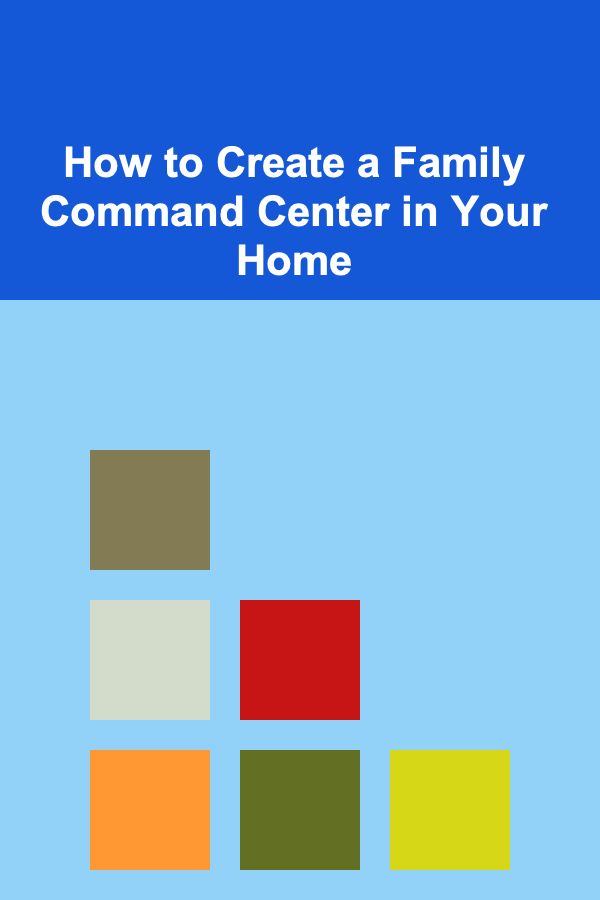
How to Create a Family Command Center in Your Home
ebook include PDF & Audio bundle (Micro Guide)
$12.99$8.99
Limited Time Offer! Order within the next:

In today's fast-paced world, managing family life can often feel overwhelming. Between work schedules, school activities, appointments, and social engagements, it's easy for important tasks and commitments to slip through the cracks. A family command center serves as a centralized hub where family members can manage schedules, organize essential information, and streamline communication. This comprehensive guide will explore what a family command center is, its benefits, how to create one, and tips for maintaining its effectiveness.
What is a Family Command Center?
A family command center is a designated space within your home that acts as a central point for managing family operations. It typically includes organizational tools such as calendars, to-do lists, important documents, and other resources to help keep family members informed and coordinated.
Common Features of a Family Command Center
- Calendar System: A visible calendar that tracks family schedules, appointments, and events.
- To-Do Lists: Lists for daily tasks, chores, and shopping needs.
- Mail Station: A designated area for incoming mail, bills, and important documents.
- Communication Board: A bulletin board for notes, reminders, and messages among family members.
- Storage Solutions: Bins, baskets, or folders to store frequently used items like keys, chargers, or school supplies.
Benefits of a Family Command Center
1. Enhanced Organization
A centralized command center helps families stay organized by consolidating essential information in one location, reducing clutter and confusion throughout the home.
2. Improved Communication
Having a designated space for family members to share information fosters better communication. Everyone stays aligned on schedules, responsibilities, and commitments.
3. Increased Efficiency
A well-organized command center streamlines daily tasks, making it easier for family members to access necessary information quickly---whether it's checking the calendar or reviewing to-do lists.
4. Reduced Stress
When everyone knows where to find important information and what tasks need to be completed, stress levels can significantly decrease. Families can focus more on enjoying quality time together.
5. Promotes Accountability
With clear visual reminders of tasks and schedules, family members can take ownership of their responsibilities and become more accountable for managing their time effectively.
Steps to Create Your Family Command Center
Creating an effective family command center involves careful planning, organization, and customization to fit your family's unique needs. Here's a step-by-step approach:
Step 1: Choose the Right Location
Selecting an appropriate space for your command center is crucial. Consider these factors when choosing a location:
- Visibility: Choose a spot that is easily accessible and visible to all family members. High-traffic areas like the kitchen, entryway, or family room work well.
- Size: Ensure the area has enough space to accommodate the organizational tools you plan to include.
- Functionality: Consider how the space will be used. It should facilitate daily activities while being aesthetically pleasing.
Step 2: Gather Necessary Materials
Once you've chosen a location, gather materials to set up the command center. Common items include:
- Calendars: Wall calendars, dry-erase boards, or digital options.
- Bulletin Boards: Corkboards or magnetic boards for posting notes and reminders.
- Organizational Tools: Baskets, bins, folders, or file organizers to store paperwork and school supplies.
- Writing Utensils: Markers, pens, or sticky notes for jotting down quick reminders.
- Labels: Labels for organizing items and enhancing clarity.
Step 3: Set Up a Calendar System
A calendar is at the heart of any efficient family command center. Here's how to establish a calendar system:
A. Choose Your Calendar Format
Decide whether you prefer a physical wall calendar, a whiteboard, or a digital calendar that everyone can access via smartphones or tablets. A combination of methods may work best.
B. Color-Coding
Implement a color-coding system to differentiate between various family members' activities. Assign a specific color to each person to make tracking schedules easier.
C. Include Important Dates
Ensure the calendar includes key dates such as:
- School holidays
- Family birthdays
- Appointments and events
Step 4: Create To-Do Lists
To-do lists help manage daily tasks and responsibilities. Here's how to create effective lists:
A. Daily and Weekly Lists
Establish daily and weekly to-do lists to keep track of ongoing responsibilities. Use a whiteboard, notepad, or an app to jot down tasks.
B. Assign Tasks
Encourage family members to take responsibility for specific tasks. Clearly assigning chores fosters accountability and teamwork.
C. Regular Reviews
Schedule regular check-ins (weekly or bi-weekly) to review to-do lists together and update them as needed. This practice promotes collaboration and communication.
Step 5: Designate a Mail Station
Managing incoming mail can prevent clutter and ensure important documents are handled promptly. Here's how to set up a mail station:
A. Create Folders
Use labeled folders or bins for different categories of mail, such as:
- Bills
- School notices
- Personal letters
B. Regular Sorting
Establish a routine for sorting through mail---daily or weekly---so items don't pile up. Encourage family members to handle mail immediately upon receipt.
C. Document Storage
Consider setting up a small filing cabinet or binder for important documents---such as insurance papers, tax documents, and medical records---keeping them easily accessible.
Step 6: Implement a Communication Board
A communication board enhances family interaction and engagement. Here's how to create an effective board:
A. Select the Right Board
Choose a bulletin board or magnetic board that fits your space. Ensure it's easily visible and accessible.
B. Use Visual Elements
Incorporate sticky notes, magnets, or printed messages to share updates, reminders, and notes among family members.
C. Encourage Participation
Make the communication board a collaborative effort. Encourage family members to add notes, greetings, or important reminders.
Step 7: Incorporate Storage Solutions
Effective storage solutions keep your command center organized and functional. Here are some ideas:
A. Baskets and Bins
Use labeled baskets or bins to hold school supplies, art materials, or sports gear. Keeping items grouped and labeled simplifies retrieval.
B. Desktop Organizers
Utilize desktop organizers for pens, notebooks, and other frequently used tools. This keeps your command center tidy and looks inviting.
C. Hooks and Racks
Install hooks or racks for hanging bags, jackets, or keys near the command center. This helps reduce clutter in other areas of the home.
Step 8: Personalize the Space
Adding personal touches to your command center can make it more inviting. Consider these suggestions:
A. Family Photos
Incorporate family photos or artwork to make the space feel warm and welcoming. Rotating artwork created by kids can also foster creativity.
B. Quotes and Inspiration
Display motivational quotes or affirmations that resonate with your family's values and goals. This can serve as a positive reminder for everyone.
C. Seasonal Decor
Change the decor seasonally to keep things fresh and engaging. Incorporate seasonal colors or themes to reflect holidays and special occasions.
Step 9: Schedule Regular Maintenance
Once your command center is set up, ensure it remains effective through regular maintenance. Here's how:
A. Weekly Check-Ins
Schedule a weekly check-in to review calendars, to-do lists, and mail. Use this time to adjust plans and discuss upcoming events.
B. Monthly Refresh
Plan a monthly refresh session where family members can declutter the command center, remove outdated items, and reorganize as needed.
C. Encourage Ownership
Encourage each family member to take ownership of maintaining their section of the command center. This can promote accountability and reduce the burden on one individual.
Troubleshooting Common Challenges
While creating and maintaining a family command center can be beneficial, challenges may arise. Here are some common issues and how to address them:
1. Resistance to Change
Family members may initially resist the new organization system. Consider involving everyone in the planning process to increase buy-in and cooperation.
2. Overwhelm from Clutter
If your command center becomes cluttered quickly, reassess your storage solutions. Limit the number of items displayed and regularly sort through materials to maintain order.
3. Lack of Engagement
If family members aren't using the command center, explore ways to make it more inviting. Add fun elements like colored markers, creative visuals, or interactive components.
4. Inconsistent Maintenance
To combat inconsistent maintenance, schedule specific times for regular reviews and updates. Make these sessions a family tradition to ensure everyone participates.
Conclusion
Creating a family command center in your home can transform the way your family organizes its schedules, communicates, and manages daily tasks. By following the steps outlined in this guide---choosing the right location, gathering materials, setting up systems, personalizing the space, and establishing regular maintenance---you can develop a functional and inviting command center that meets your family's unique needs.
The ultimate goal is to enhance organization, improve communication, and reduce stress, allowing families to focus on spending quality time together. Embrace the process, involve all family members, and enjoy the benefits of a well-organized household. Happy organizing!
Reading More From Our Other Websites
- [Ziplining Tip 101] Best Eco‑Conscious Ziplining Adventures in the Pacific Northwest for Sustainable Travelers
- [Organization Tip 101] How to Teach Kids the Importance of Shoe Organization
- [Toy Making Tip 101] The Art of Renewal: Designing Personalized Toys for Life's Next Adventure
- [Home Renovating 101] How to Remodel a Living Room for a Fresh, Modern Look
- [Home Rental Property 101] How to Build a Tenant Retention Strategy
- [Home Lighting 101] How to Mix Different Lighting Styles to Add Depth to Your Home
- [Organization Tip 101] Best Organization Tools for Travel Planning
- [Home Space Saving 101] How to Design a Small Walk-In Closet with Maximum Storage
- [Home Party Planning 101] How to Use DIY Decor to Personalize Your Home Party
- [Home Budget 101] How to Create a Budget for Home Improvement Projects

Best Practices for Writing Copy for One-Page Websites
Read More
How to Create a Toy Maintenance Schedule
Read More
How to Decorate Your Home with DIY Projects
Read More
Top DIY Gardening and Landscaping Ideas to Transform Your Outdoor Space
Read More
Building Your Child's Self-Esteem and Confidence: A Comprehensive Guide
Read More
How to Build a Weekly Job Search To-Do List You Can Stick To
Read MoreOther Products

Best Practices for Writing Copy for One-Page Websites
Read More
How to Create a Toy Maintenance Schedule
Read More
How to Decorate Your Home with DIY Projects
Read More
Top DIY Gardening and Landscaping Ideas to Transform Your Outdoor Space
Read More
Building Your Child's Self-Esteem and Confidence: A Comprehensive Guide
Read More